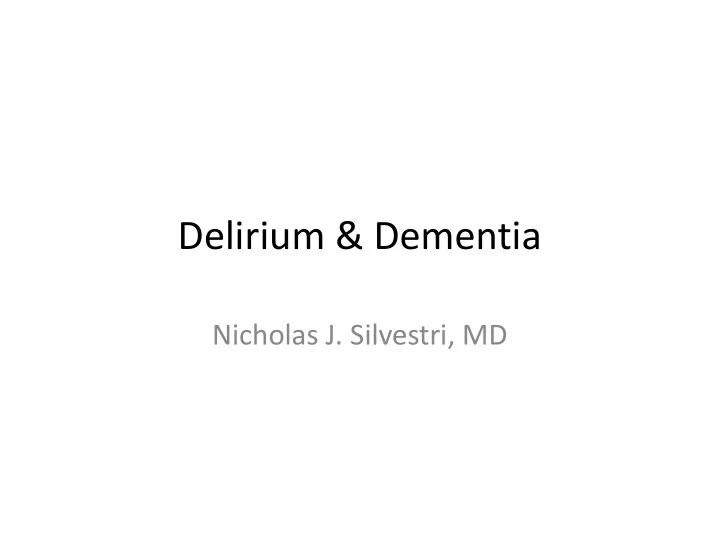

Delirium & Dementia Nicholas J. Silvestri, MD
Outline • Delirium vs. Dementia • Neural pathways relating to consciousness • Encephalopathy • “Stupor” • Coma • Dementia
Delirium vs. Dementia • Delirium • Dementia – Abrupt onset – Insidious onset – Lasts hours-days – Lasts months-years – Reduced attention – Normal attention – Fluctuating – Consciousness intact consciousness – Speech disorganized – Speech largely intact – Usually reversible – Usually irreversible
Underlying Pathways
Underlying Pathways
Encephalopathy • The inability to maintain a coherent stream of thought or action • Inattentive • Easily distractible
Causes of Encephalopathy • Toxic-Metabolic • Infectious • Vascular (e.g. hypertensive encephalopathy) • Traumatic (e.g. concussion, hemorrhage) • Epileptic (e.g. post-ictal state)
Metabolic Encephalopathy • Drugs (EtOH, sedatives, narcotics) • Endocrine (hypo- or hyper- thyroid, glycemia) • Electrolyte (hypernatremia, hypercalcemia) • Nutritional (B1 or B12 deficiency) • Organ system failure (renal, hepatic)
Infectious Encephalopathy • Encephalitis vs. meningitis • Important to consider if fever present • Quick institution of therapy necessary • Low threshold for LP
Stupor, Obtundation, and Other Bad Words
Coma • Patient is unconscious • No purposeful response to the environment – Spontaneous, to command, to noxious stimuli • Cannot be aroused • Eyes closed
Etiology of Coma • Medical • Surgical – Diffuse hypoxia/ischemia – Intracranial hemorrhage – Dysglycemia – Intracerebral masses – Organ failure or – Large strokes dysfunction – Traumatic brain injury – Intoxications – Severe electrolyte imbalances – CNS infections
Brain Death • Irreversible cessation of all brain function • Synonymous with death in NYS • Cause of coma must be known • Other confounders must be ruled-out – e.g. drug intoxication, hypothermia, etc.
Examination in Coma • Assess for arousal • Examine eyes – Pupillary response, corneal response, oculocephalic response • Evaluate for gag reflex • Evaluate for response to noxious stimuli • Evaluate motor response to noxious stimuli
Dementia • Progressive disorder of cognitive function involving memory and at least one other cognitive domain
Causes of Dementia • Alzheimer’s disease • Frontotemporal dementia • Lewy Body dementia • Vascular dementia • Other causes
Alzheimer’s Disease • Most common cause of dementia • Prevalence increases with age • Usually sporadic (95% of cases)
Pathogenesis • β-amyloid- forms neuritic plaques- extracellular deposits • Neurofibrillary tangles- intracellular deposits containing hyperphosphorylated τ protein and ubiquitin • Cholinergic deficiency – Degeneration of nucleus basalis of Meynert and septal-hippocampal tract
Pathology
MRI in Alzheimer’s Disease
Clinical Manifestations • Early – Recent memory difficulty – Anomia (word-finding difficulty) – Visuospatial dysfunction • Late – Disinhibition – Psychiatric manifestations – Eventually akinetic mutism
Treatment • Acetylcholinesterase inhibitors – Donepezil, rivastigmine, galantamine • NMDA-glutamate receptor antagonist – Memantine • Symptomatic treatment – For psychosis, depression, etc. • Supportive care
Frontotemporal Dementia • Earlier onset than Alzheimer’s • More prominent behavioral than cognitive dysfunction at onset • Preferential atrophy of frontal and anterior temporal lobes • Due to abnormal accumulation of τ protein • No treatment
Frontotemporal Dementia
Lewy Body Dementia • Second most common cause of dementia • Caused by presence of Lewy bodies throughout the cortex made up of α-synuclein
Clinical Features • Dementia – Memory less prominently involved than Alzheimer • Parkinsonism – Tremor, bradykinesia, rigidity, gait dysfunction • Fluctuation of cognition • Visual hallucinations
Vascular Dementia • Third most common cause of dementia • Relationship between cerebrovascular disease and dementia is poorly characterized • Pathogenesis – 1. Multiple strategic infarcts – 2. Confluent white matter disease – 3. Both
Vascular Dementia
Vascular Dementia • “Step-wise progression” • Treatment is supportive – Largely aimed at treating modifiable vascular risk factors (blood pressure, lipids, diabetes)
Other Causes of Dementia • Potentially reversible causes – Hyper- or hypothyroidism – normal pressure hydrocephalus – B12 deficiency – neurosyphilis • Associated with other disease – Parkinson’s disease – AIDS
Neurological Manifestations of HIV • Seen in up to 70% of patients with HIV/AIDS • Two major pathophysiologic mechanisms: – Direct effects of HIV on nervous system – Opportunistic infections
Neuro-cognitive Symptoms • Subcortical dementia • Difficulties with attention and concentration • Slow processing speed • Mild short term memory dysfunction • Decline in psychomotor function – Fine hand movements, gait incooordination
MRI Findings
AIDS Dementia Complex • a.k.a. HIV encephalopathy • Occurs later in disease course • More severe cognitive and behavioral deficits • Can see widespread white matter disease and atrophy on MRI
Questions?
Recommend
More recommend